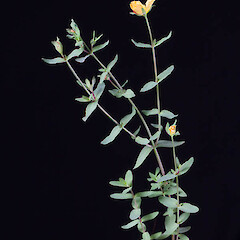Hypericum involutum
Common name
grassland hypericum
Family
Hypericaceae
Flora category
Vascular – Native
Endemic taxon
No
Endemic genus
No
Endemic family
No
Structural class
Herbs - Dicotyledons other than Composites
NVS code
The National Vegetation Survey (NVS) Databank is a physical archive and electronic databank containing records of over 94,000 vegetation survey plots - including data from over 19,000 permanent plots. NVS maintains a standard set of species code abbreviations that correspond to standard scientific plant names from the Ngä Tipu o Aotearoa - New Zealand Plants database.
HYPINV
Chromosome number
2n = 16
Current conservation status
The conservation status of all known New Zealand vascular plant taxa at the rank of species and below were reassessed in 2017 using the New Zealand Threat Classification System (NZTCS) – more information about this can be found on the NZTCS website. This report includes a statistical summary and brief notes on changes since 2012 and replaces all previous NZTCS lists for vascular plants.
Please note, threat classifications are often suggested by authors when publications fall between NZTCS assessment periods – an interim threat classification status has not been assessed by the NZTCS panel.
- Conservation status of New Zealand indigenous vascular plants, 2017 . 2018. Peter J. de Lange, Jeremy R. Rolfe, John W. Barkla, Shannel P. Courtney, Paul D. Champion, Leon R. Perrie, Sarah M. Beadel, Kerry A. Ford, Ilse Breitwieser, Ines Schönberger, Rowan Hindmarsh-Walls, Peter B. Heenan and Kate Ladley. Department of Conservation. Source: NZTCS and licensed by DOC for reuse under the Creative Commons Attribution 4.0 International licence.
2017 | At Risk – Declining | Qualifiers: DP, SO
Previous conservation statuses
2012 | At Risk – Declining | Qualifiers: DP, SO
2009 | Not Threatened
2004 | Not Threatened
Distribution
Indigenous. New Zealand: North and South Islands from Te Paki south to Southland but scarce north of the Waikato.
Habitat
Coastal to montane. Inhabiting dry and open sites such on and around rock outcrops, in open scrub, Kunzea forest/woodland, and in sparsely-vegetated tussock-grassland.
Detailed description
Herbaceous perennial, woody stock, not rhizomatous, up to 250 mm high. Stems erect, up to 1.3 mm diameter, quadrangular, 4-lined, black glands absent, unbranched or branched only from base. Leaves 2.5-20.0 × 0.7-6.8 mm, lanceolate, ovate, ovate-elliptic, elliptic oblong or broadly elliptic, glabrous, reticulate tertiary veins absent; pellucid glands conspicuous; black glands absent; apex subacute or obtuse; margin entire and sometimes recurved; base subcordate or ± amplexicaul; sessile. Inflorescence terminal, lax dichasial cymes, flowers 1-10 per cyme, corolla up to 17.0 mm. Pedicels 4.0-40.0 mm long. Bracteoles absent. Sepals 5, 3.0-7.0 × 1.0-2.5 mm, unequal, lanceolate, elliptic, elliptic-oblong or broadly elliptic; pellucid glands abundant, usually linear; black glands absent; apex acute or subacute; margin entire. Petals up to 8.0 mm long and up to 4.5 mm wide, > sepals, golden yellow, black glands absent, persistent after anthesis. Stamens not in bundles, 30-43, 3.3-4.5 mm long, < petals; anthers 0.25-0.3 mm long, anther gland absent. Ovary 3.0-3.5 × 1.5-2.5 mm, ovoid. Styles 3, 1.0-1.8 mm long, < ovary. Fruit capsule, 5.0-9.5 × 3.2-4.5 mm, ovoid, light brown, conspicuously protruding beyond sepals, coriaceous. Seeds 0.6-0.85 × 0.25-0.4 mm, oblong, terete, yellow to yellow-brown, longitudinal ribs, apices obtuse or rounded. Description from Heenan (2011).
Similar taxa
Hypericum involutum is distinguished from all other New Zealand Hypericum species by the absence of black glands, erect, quadrangular and 4-lined stems that branch from a woody base, 3 styles, and the infloresecence is terminal and with solitary flowers or with few-flowered dichasial cymes.
Flowering
October - March
Flower colours
Orange, Yellow
Fruiting
November - June
Life cycle
Seeds are wind and water dispersed (Thorsen et al., 2009).
Propagation technique
Easily grown in an open, free-draining soil. Inclined to be somewhat weedy.
Etymology
hypericum: From the Greek hyper (above) and eikon (picture), the plant was hung above pictures to ward off evil spirits
Where To Buy
Not commercially available
Attribution
Fact sheet prepared for NZPCN by P.J. de Lange (17 April 2011). Description from Heenan (2011)
References and further reading
Heenan, P.B. 2011: Taxonomic notes on the New Zealand flora: Hypericum gramineum and Hypericum involutum (Hypericaceae). New Zealand Journal of Botany 49: 133-139.
Thorsen, M.J.; Dickinson, K.J.M.; Seddon, P.J. 2009: Seed dispersal systems in the New Zealand flora. Perspectives in Plant Ecology, Evolution and Systematics 11: 285-309.
NZPCN Fact Sheet citation
Please cite as: de Lange, P.J. (Year at time of access): Hypericum involutum Fact Sheet (content continuously updated). New Zealand Plant Conservation Network. https://www.nzpcn.org.nz/flora/species/hypericum-involutum/ (Date website was queried)







